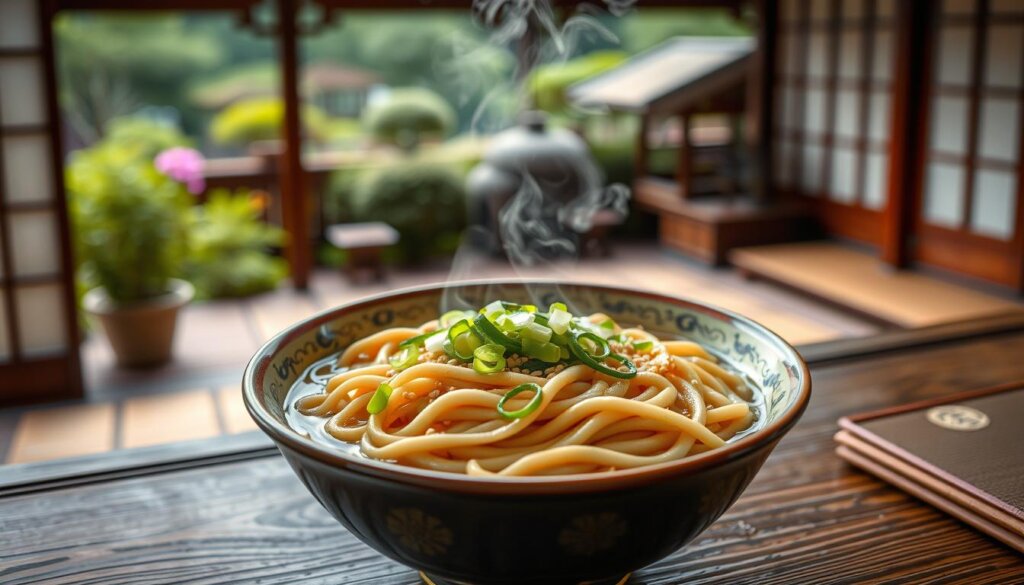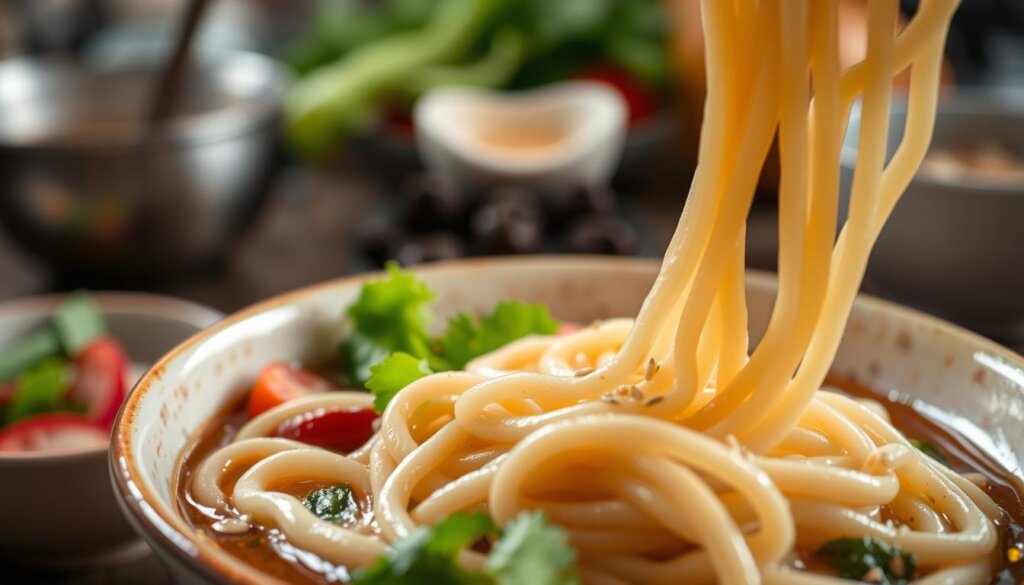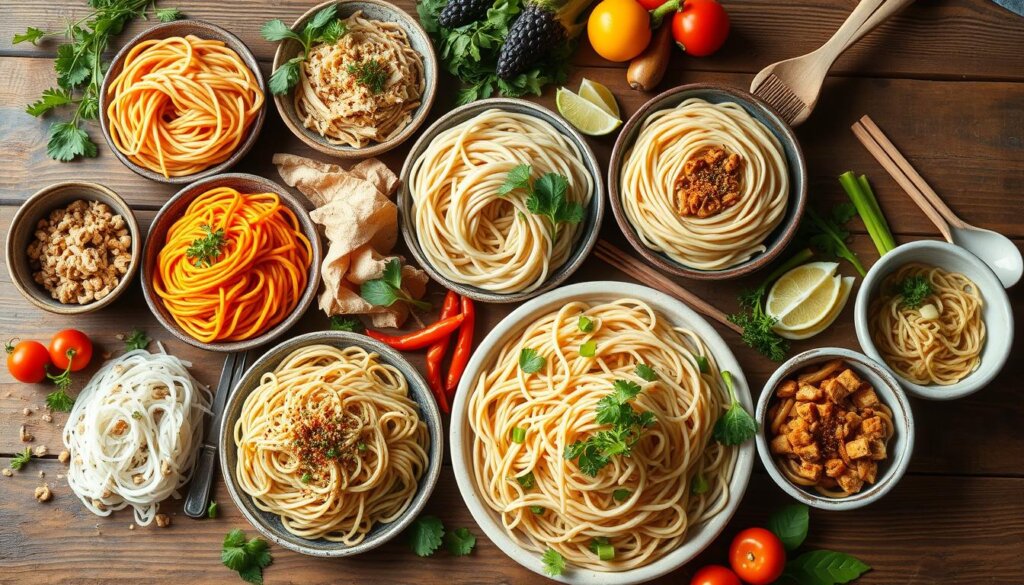Ever wondered if your favorite Japanese noodles could be sabotaging your gluten-free diet? Udon noodles, known for their thick and chewy texture, are a staple in many Asian dishes.
Unfortunately, traditional udon noodles are made with wheat flour, making them unsuitable for those with celiac disease or gluten sensitivity. But don’t worry—there are now gluten-free udon options available! If you’re exploring gluten-free alternatives, check out our guide to Easy Gluten-Free Grain-Free Wraps or learn about Gluten-Free Substitutes for Common Ingredients.
Table of contents
Understanding Traditional Udon Noodles
Udon noodles are a key part of Japanese cuisine. They offer a special taste experience with simple ingredients and expert preparation. These thick, chewy noodles are loved for their unique texture and how well they work with different flavors.

Components of Classic Udon
Making real udon noodles needs just a few, but important, ingredients. The basic recipe includes:
- High-quality wheat flour
- Pure water
- Fine salt
The secret of udon is in the kneading udon dough process. This turns simple ingredients into a culinary wonder. Chefs spend a lot of time kneading the dough to get its chewy texture just right.
Cultural Significance in Japanese Cuisine
“Udon is more than just a noodle; it’s a reflection of Japanese culinary artistry and tradition.”
In Japanese food, udon is a versatile staple. It’s found in many dishes, from warm soups to lively stir-fries. This shows how well it can adapt to different tastes.
Traditional Preparation Methods
The art of making udon involves several careful steps:
- Mixing wheat flour with water and salt
- Intensive kneading to develop gluten strands
- Allowing the dough to rest
- Rolling out the dough carefully
- Cutting into thick, uniform noodle strands
Learning these techniques takes time and effort. It shows the deep respect for food craftsmanship in Japanese culture.
What is Gluten and Its Effects on Health
Gluten is a complex substance in many foods that can affect your health. Knowing about it and its risks is key to staying healthy.
Celiac Disease and Gluten Sensitivity
About 18 million Americans have gluten sensitivity. Celiac disease affects 0.5% to 1% of the world’s population. It causes an autoimmune reaction to gluten, leading to serious health issues.
- Non-celiac gluten sensitivity mostly affects women and young adults
- Symptoms can range from mild stomach issues to severe intestinal damage
- Up to 95% of children with celiac disease see intestinal healing after two years on a gluten-free diet
Common Sources of Gluten
Gluten is mainly in wheat, barley, and rye. Foods with gluten include:
- Bread and baked goods
- Pasta
- Cereals
- Beer
- Processed foods
Health Impacts of Gluten Consumption
“Understanding your body’s response to gluten can be a critical step in managing your overall health.” – Nutrition Expert
For those with gluten intolerance, eating gluten can cause health problems. The FDA says foods must have less than 20 parts per million of gluten to be labeled “gluten-free”.
| Health Condition | Potential Gluten Impact |
|---|---|
| Bone Density | Up to 75% of untreated celiac patients experience lower bone density |
| Cancer Risk | 3x higher risk of non-Hodgkin’s lymphoma |
| Fertility | Increased risk of infertility and miscarriage |
Always consult with a healthcare professional if you suspect gluten-related health issues.
Are Udon Noodles Gluten Free
Wondering if udon noodles have gluten? The answer is yes, traditional udon noodles do contain gluten. They are made mainly from wheat flour, which has gluten. The kneading process makes them chewy.

For people with celiac disease or gluten sensitivity, udon is a problem. The wheat flour in traditional udon noodle production makes them unsuitable for those who must avoid gluten.
*”Not all noodles are created equal when it comes to gluten content.”*
- Gluten-free udon alternatives include:
- Lotus Foods Brown Rice Udon
- NM Egg White Udon Noodles
- YUHO Organic Shirataki Noodles
Fortunately, there are now gluten-free udon options available. Brands have created noodles from rice flour, buckwheat, and other gluten-free ingredients. These alternatives taste and feel like traditional udon but are safe for special diets.
When looking for gluten-free udon, check for noodles made with:
- Rice flour (1 cup)
- Tapioca flour (½ cup)
- Water (1¼ cups)
- Salt (½ teaspoon)
- Cooking oil (1 teaspoon)
These gluten-free udon noodles meet dietary needs and offer a tasty way to enjoy Japanese cuisine without health risks.
Gluten-Free Alternatives to Traditional Udon
Modern cooking has made finding tasty gluten-free udon alternatives easy. If you have gluten sensitivity or celiac disease, you’ll love the many rice flour noodles and other udon options out there.

Thanks to new ways of making food, traditional udon can now be enjoyed by those with dietary needs. This is thanks to gluten-free manufacturing.
Rice Flour Noodle Innovations
Rice flour noodles have a smooth feel and a mild taste, just like regular udon. They offer many benefits:
- They’re light and easy to digest
- They taste neutral, great for many recipes
- They cook up fast
Exploring Tapioca and Buckwheat Variations
Tapioca udon and buckwheat noodles are great gluten-free choices. Buckwheat noodles add a rich, nutty taste to your meals.
“Gluten-free doesn’t mean flavor-free – it means culinary creativity!” – Gluten-Free Cooking Enthuasiast
Modern Manufacturing Techniques
New ways of making gluten-free noodles make them almost as good as the real thing. These methods ensure:
- They have a better texture
- They taste great
- They’re always of high quality
With these amazing alternatives, you can enjoy your favorite noodle dishes without losing flavor or texture. Dive into the world of gluten-free udon and explore new recipes!
Cross-Contamination Risks in Udon Production
Understanding cross-contamination risks is key when making gluten-free udon noodles. This is important for those with celiac disease or gluten sensitivity. Manufacturers must follow strict rules to avoid gluten exposure during food making.
There are several areas where cross-contamination can happen:
- Shared manufacturing equipment
- Processing facilities handling multiple flour types
- Storage and transportation of ingredients
- Preparation surfaces and utensils
Food labeling is also very important. It helps keep consumers safe. Look for certified gluten-free labels on packaging from trusted brands.
“Prevention of cross-contamination requires meticulous attention to every step of food production.” – Gluten-Free Food Safety Expert
When shopping, look for signs of gluten-free safety. Check for dedicated gluten-free lines and third-party testing. Also, read ingredient lists carefully to spot gluten risks in udon noodles.
Manufacturers use strict cleaning and separate equipment for gluten-free products. Some even have special facilities to ensure safety for those with sensitivities.
Cooking with Gluten-Free Udon Alternatives
Exploring gluten-free udon recipes opens up a world of culinary creativity. It’s great for home cooks and food enthusiasts. Whether you have celiac disease or just want healthier options, learning about gluten-free udon noodles can change your Japanese-inspired cooking.
Recipe Adaptations for Gluten-Free Udon
Making delicious udon soup with gluten-free noodles needs some adjustments. Here are some tips for successful recipe changes:
- Choose alternative flour bases like rice flour or buckwheat
- Experiment with different noodle textures
- Adjust cooking times to prevent overcooking
- Use gentle handling techniques
Texture and Taste Considerations
The texture of udon noodles can change a lot between traditional and gluten-free. Gluten-free noodles might be less chewy. But, they can be very satisfying when cooked right.
| Noodle Type | Texture | Cooking Time |
|---|---|---|
| Rice Flour Udon | Slightly softer | 3-4 minutes |
| Buckwheat Udon | Firmer, nutty | 4-5 minutes |
| Bean-Based Udon | Smooth, delicate | 2-3 minutes |
Sauce and Seasoning Guidelines
Japanese seasonings are key to making gluten-free udon dishes great. Use gluten-free tamari instead of soy sauce. Also, try other authentic flavoring methods.
Pro tip: Always verify that your seasonings are certified gluten-free to maintain dietary restrictions.
Your gluten-free udon soup can be just as tasty and authentic as the traditional ones. Just choose the right ingredients and use the right cooking techniques.
Conclusion
Your journey through udon noodles doesn’t stop with traditional wheat-based recipes. The world of gluten-free udon options has grown a lot. This offers tasty choices for those with dietary needs.
About 1% of the world’s population has celiac disease. This has led to a big increase in demand for gluten-free noodles. This demand has pushed noodle makers to be more creative.
Looking for udon alternatives, you’ll find many gluten-free options. These are made from rice, tapioca, and cassava flour. They give you carbs and energy, just like regular noodles, but without gluten.
The gluten-free noodle market is expected to hit $7.59 billion by 2026. This shows more people are looking for different food choices.
Even though 72% of nutrition experts warn against gluten-free diets when not needed, those with gluten sensitivities can enjoy Japanese dishes. It’s important to read labels, know how to cook, and watch out for cross-contamination. With the right choices and care, you can enjoy tasty udon-style meals that fit your diet.
Gluten-free diets have grown by 67% in the last ten years. This means there are more gluten-free udon options out there. Your cooking adventures can now include a wide range of gluten-free noodle dishes.
FAQ
Are traditional udon noodles gluten-free?
No, traditional udon noodles are not gluten-free. They are made from wheat flour, which has gluten. The kneading process makes gluten strands, giving udon its chewy texture.
What are gluten-free alternatives to udon noodles?
Gluten-free udon alternatives use flours like rice, tapioca, and buckwheat. These flours offer similar textures and can be used in traditional Japanese dishes without gluten.
How can I identify gluten-free udon noodles?
Look for gluten-free labels and certification marks on packaging. Also, read ingredient lists carefully. Brands like Fortune Gluten Free Udon Noodles offer gluten-free options.
What is gluten, and why do some people avoid it?
Gluten is a protein in wheat, barley, and rye. People with celiac disease or gluten sensitivity must avoid it. Gluten can cause health issues like digestive problems and damage to the small intestine.
Can I use gluten-free udon in traditional Japanese recipes?
Yes, you can use gluten-free udon in traditional recipes. Just remember to adjust cooking times and use gluten-free alternatives like tamari instead of soy sauce.
What are the risks of cross-contamination with gluten-free udon?
Cross-contamination can happen during production or cooking. This occurs when equipment or facilities are used for gluten-containing products. Always choose certified gluten-free products and be careful about how they are prepared.
What flour works best for homemade gluten-free udon?
A mix of rice flour and tapioca flour works well for texture. Buckwheat flour adds a nutty flavor and is gluten-free. Try different ratios to find the right consistency.
Are all Asian noodles gluten-containing?
No, not all Asian noodles have gluten. Rice noodles, glass noodles from mung bean starch, and buckwheat soba noodles are naturally gluten-free. They are great alternatives in Asian cuisine.





